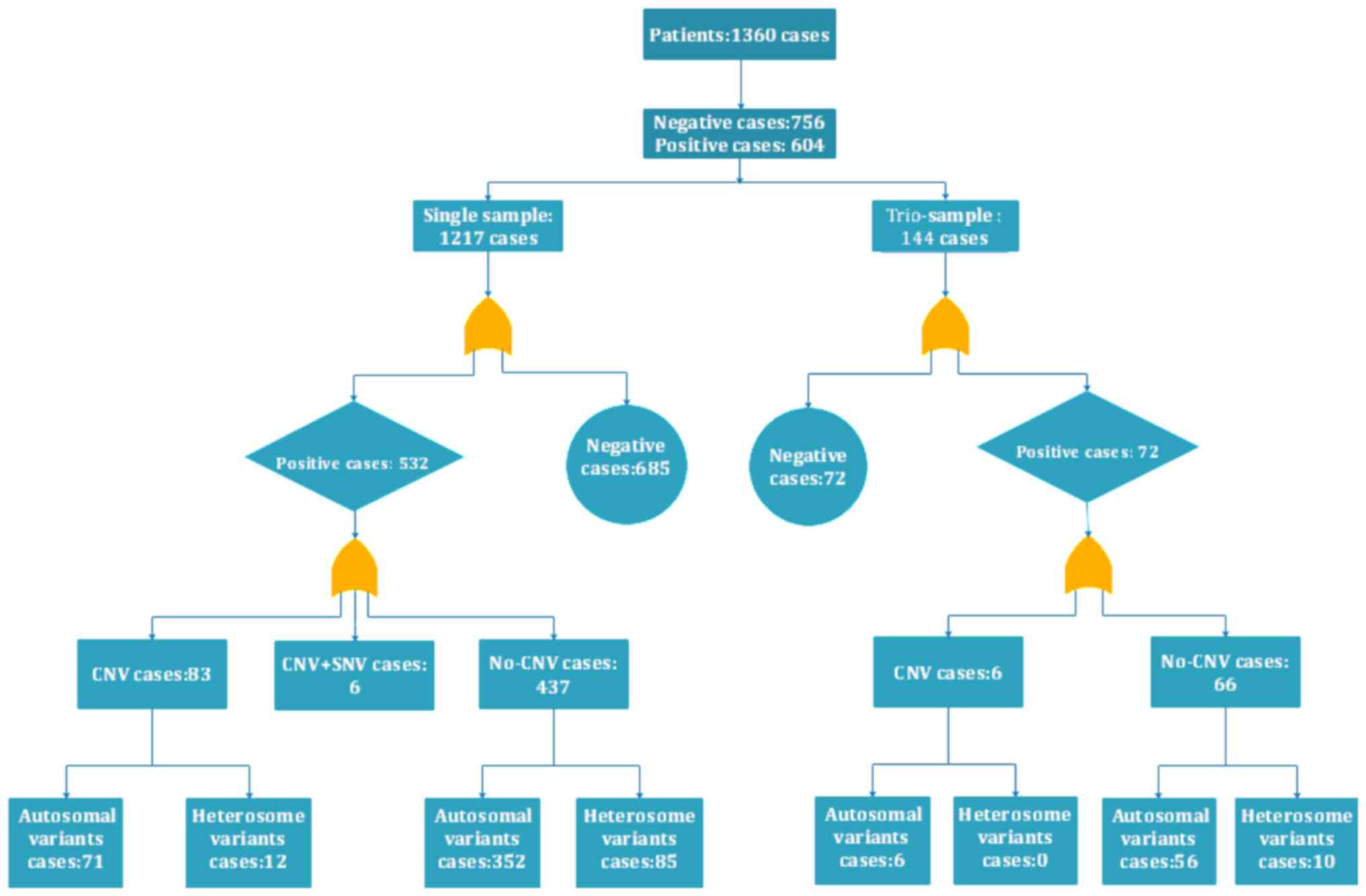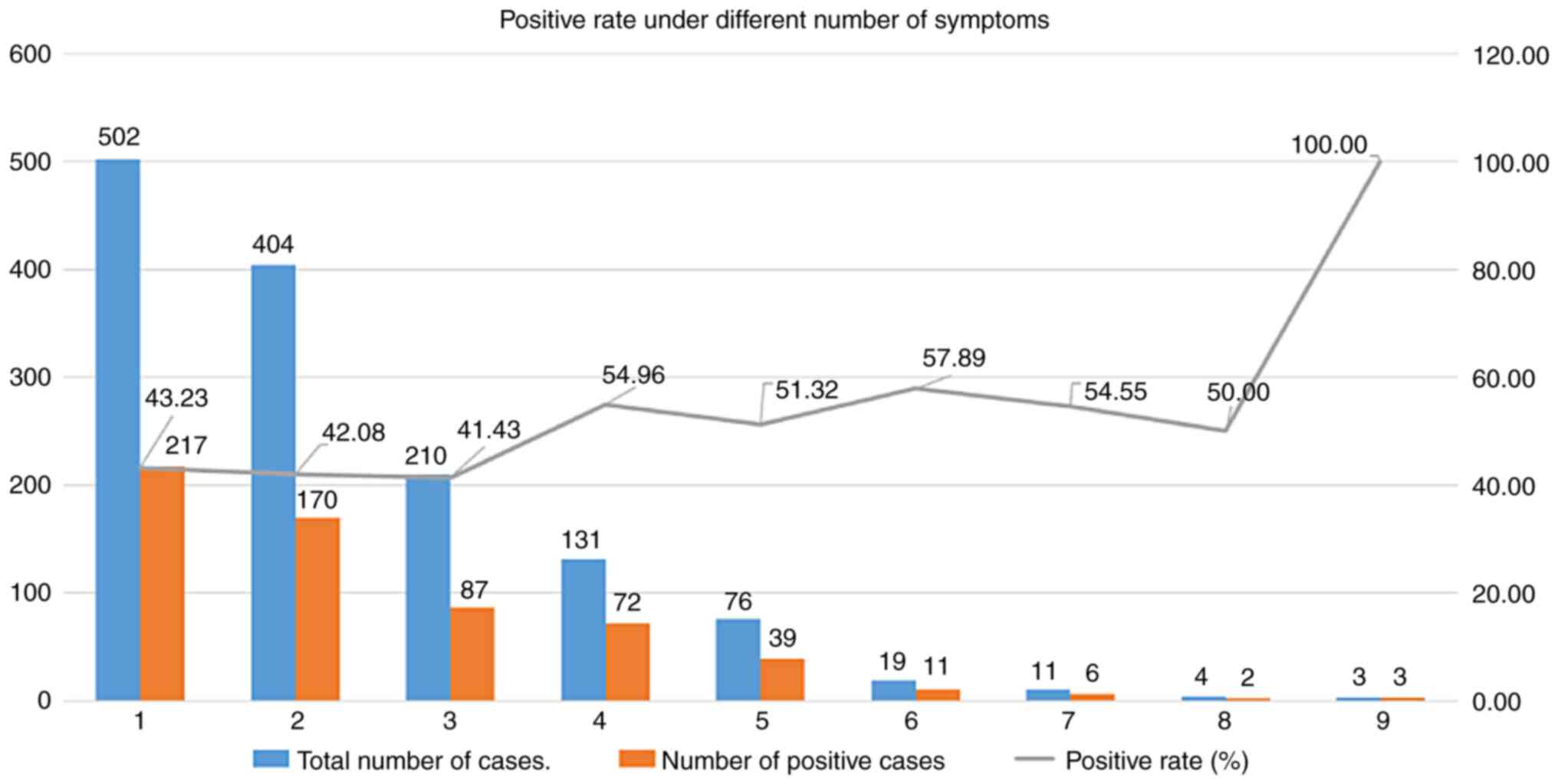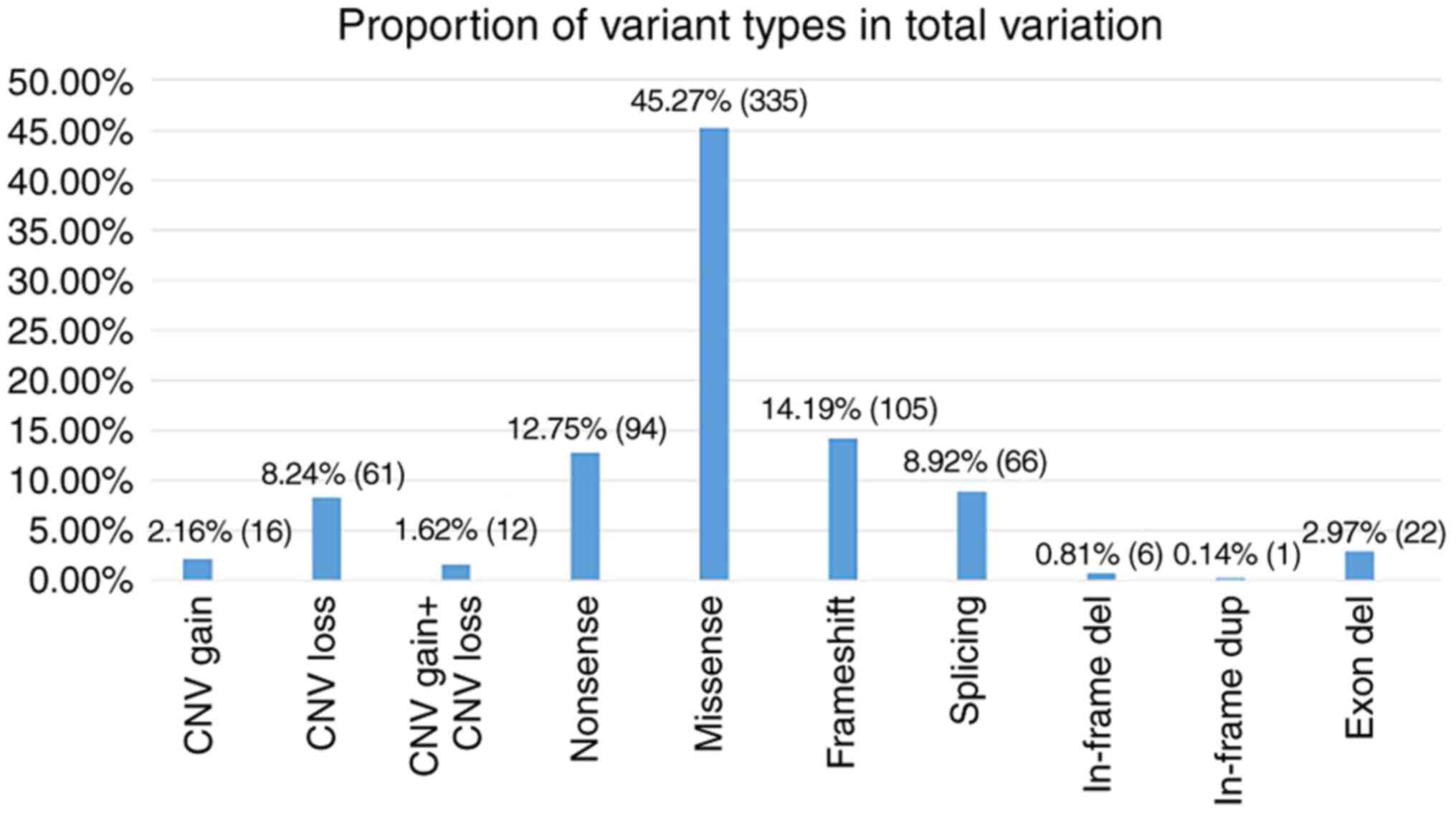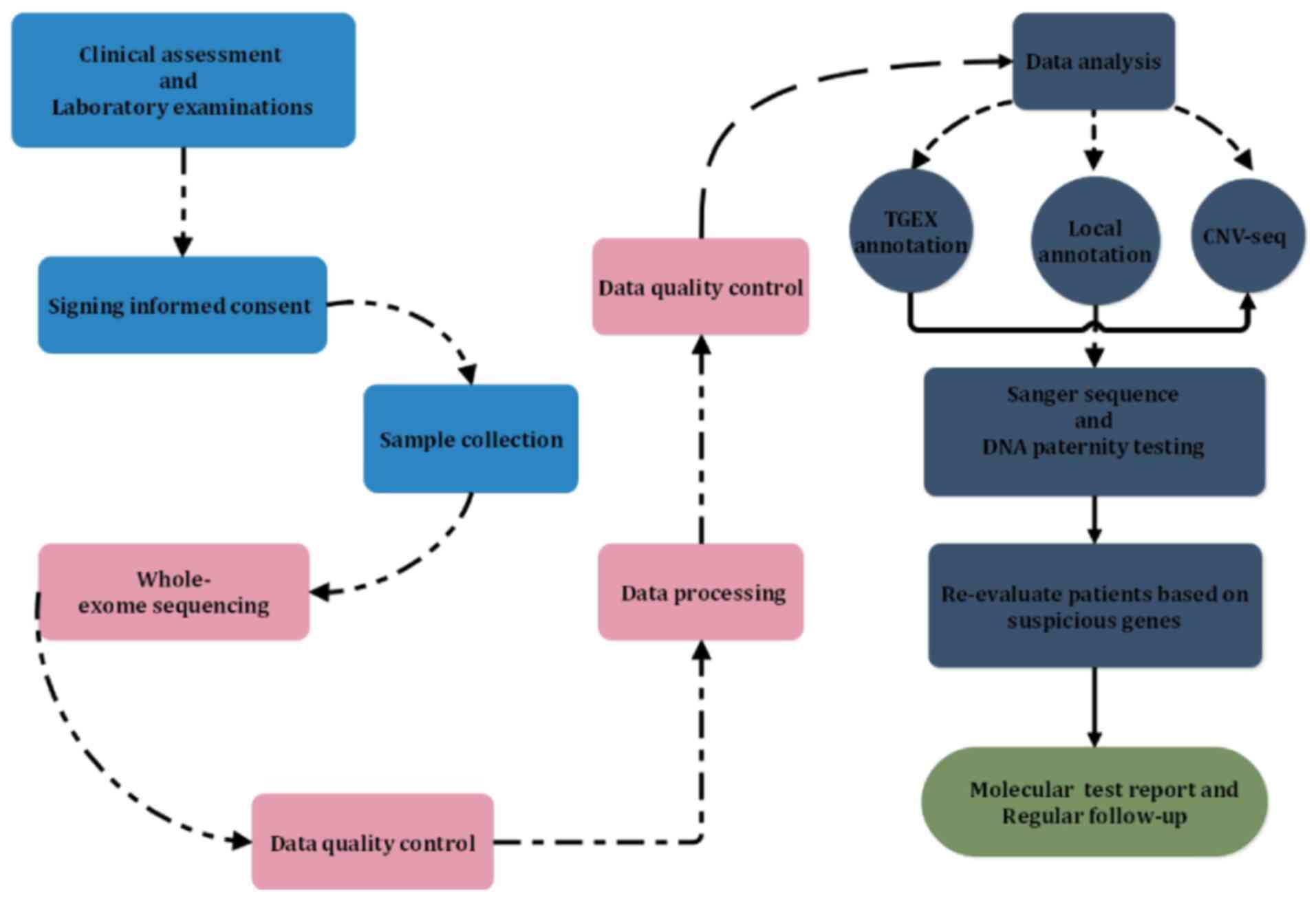|
1
|
Yu M, Ping Z, Zhang S, He Y, Dong R and
Guo X: The survey of birth defects rate based on birth registration
system. Chin Med J (Engl). 128:7–14. 2015.PubMed/NCBI View Article : Google Scholar
|
|
2
|
Cai L, Zheng LA and He L: The forty years
of medical genetics in China. J Genet Genomics. 45:569–582.
2018.PubMed/NCBI View Article : Google Scholar
|
|
3
|
Zhang Q, He L and Shen YP: The arrival of
the clinical whole genome era. Zhonghua Er Ke Za Zhi. 57:401–404.
2019.PubMed/NCBI View Article : Google Scholar : (In Chinese).
|
|
4
|
Cram DS and Zhou D: Next generation
sequencing: Coping with rare genetic diseases in China. Intractable
Rare Dis Res. 5:140–144. 2016.PubMed/NCBI View Article : Google Scholar
|
|
5
|
Zhao X, Wang P, Tao X and Zhong N: Genetic
services and testing in China. J Community Genet. 4:379–390.
2013.PubMed/NCBI View Article : Google Scholar
|
|
6
|
Ng SB, Turner EH, Robertson PD, Flygare
SD, Bigham AW, Lee C, Shaffer T, Wong M, Bhattacharjee A, Eichler
EE, et al: Targeted capture and massively parallel sequencing of 12
human exomes. Nature. 461:272–276. 2009.PubMed/NCBI View Article : Google Scholar
|
|
7
|
Dillon OJ, Lunke S, Stark Z, Yeung A and
Thorne N: Melbourne Genomics Health Alliance. Gaff C, White SM and
Tan TY: Exome sequencing has higher diagnostic yield compared to
simulated disease-specific panels in children with suspected
monogenic disorders. Eur J Hum Genet. 26:644–651. 2018.PubMed/NCBI View Article : Google Scholar
|
|
8
|
Chen P, He G, Zou X, Zhang X, Li J, Wang
Z, Gao H, Luo L, Zhang Z, Yu J and Han Y: Genetic diversities and
phylogenetic analyses of three Chinese main ethnic groups in
southwest China: A Y-Chromosomal STR study. Sci Rep.
8(15339)2018.PubMed/NCBI View Article : Google Scholar
|
|
9
|
Business Wire: The Maternal and Children
Health Hospital of Guangxi Zhuang Autonomous Region and LifeMap
Sciences Join Hands to Improve Diagnosis for Rare Diseases.
Business Wire, Inc., 2018. https://www.businesswire.com/news/home/20180417005741/en/Maternal-Children-Health-Hospital-Guangxi-Zhuang-Autonomous.%20Journal.
Accessed April 17, 2018.
|
|
10
|
Hu P, Qin YH, Jing CX, Lu L, Hu B and Du
PF: Does the geographical gradient of ApoE4 allele exist in China?
A systemic comparison among multiple Chinese populations. Mol Biol
Rep. 38:489–494. 2011.PubMed/NCBI View Article : Google Scholar
|
|
11
|
Li H and Durbin R: Fast and accurate
long-read alignment with Burrows-Wheeler transform. Bioinformatics.
26:589–595. 2010.PubMed/NCBI View Article : Google Scholar
|
|
12
|
Van der Auwera GA, Carneiro MO, Hartl C,
Poplin R, Angel GD, Levy-Moonshine A, Jordan T, Shakir K, Roazen D,
Thibault J, et al: From FastQ data to high confidence variant
calls: The genome analysis toolkit best practices pipeline. Curr
Protoc Bioinformatics. 43:11.10.11–11.10.33. 2013.PubMed/NCBI View Article : Google Scholar
|
|
13
|
Abel HJ, Duncavage EJ, Becker N, Armstrong
JR, Magrini VJ and Pfeifer JD: SLOPE: A quick and accurate method
for locating non-SNP structural variation from targeted
next-generation sequence data. Bioinformatics. 26:2684–2688.
2010.PubMed/NCBI View Article : Google Scholar
|
|
14
|
Yoon S, Xuan Z, Makarov V, Ye K and Sebat
J: Sensitive and accurate detection of copy number variants using
read depth of coverage. Genome Res. 19:1586–1592. 2009.PubMed/NCBI View Article : Google Scholar
|
|
15
|
Li C and Hung Wong W: Model-based analysis
of oligonucleotide arrays: Model validation, design issues and
standard error application. Genome Biol.
2(RESEARCH0032)2001.PubMed/NCBI View Article : Google Scholar
|
|
16
|
Li X, Chen S, Chen F, Xie W, Wang J, Wang
J, Yang H and Zhang X: A kind of copy number mutation detection
method and system. CN Patent CN104221022B. Filed April 5, 2014;
issued November 21, 2017.
|
|
17
|
Li Q and Wang K: InterVar: Clinical
interpretation of genetic Variants by the 2015 ACMG-AMP guidelines.
Am J Hum Genet. 100:267–280. 2017.PubMed/NCBI View Article : Google Scholar
|
|
18
|
Editorial Board, Chinese Journal of
Pediatrics. Consensus recommendations for the clinical application
of genetic testing for children's genetic diseases. Zhonghua Er Ke
Za Zhi. 57:172–176. 2019.PubMed/NCBI View Article : Google Scholar : (In Chinese).
|
|
19
|
Richards S, Aziz N, Bale S, Bick D, Das S,
Gastier-Foster J, Grody WW, Hegde M, Lyon E, Spector E, et al:
Standards and guidelines for the interpretation of sequence
variants: A joint consensus recommendation of the American college
of medical genetics and genomics and the association for molecular
pathology. Genet Med. 17:405–424. 2015.PubMed/NCBI View Article : Google Scholar
|
|
20
|
Jamuar SS and Tan EC: Clinical application
of next-generation sequencing for Mendelian diseases. Hum Genomics.
9(10)2015.PubMed/NCBI View Article : Google Scholar
|
|
21
|
Harris J: Germline manipulation and our
future worlds. Am J Bioeth. 15:30–34. 2015.PubMed/NCBI View Article : Google Scholar
|
|
22
|
Baird PA, Anderson TW, Newcombe HB and
Lowry RB: Genetic disorders in children and young adults: A
population study. Am J Hum Genet. 42:677–693. 1988.PubMed/NCBI
|
|
23
|
Valdez R, Grosse SD and Khoury MJ: The
need for a next-generation public health response to rare diseases.
Genet Med. 19:489–490. 2016.PubMed/NCBI View Article : Google Scholar
|
|
24
|
Zhao M and Wei DQ: Rare Diseases: Drug
discovery and informatics resource. Interdiscip Sci. 10:195–204.
2018.PubMed/NCBI View Article : Google Scholar
|
|
25
|
Reches A, Hiersch L, Simchoni S, Barel D,
Greenberg R, Ben Sira L, Malinger G and Yaron Y: Whole-exome
sequencing in fetuses with central nervous system abnormalities. J
Perinatol. 38:1301–1308. 2018.PubMed/NCBI View Article : Google Scholar
|
|
26
|
Caylor RC, Grote L, Thiffault I, Farrow
EG, Willig L, Soden S, Amudhavalli SM, Nopper AJ, Horii KA, Fleming
E, et al: Incidental diagnosis of tuberous sclerosis complex by
exome sequencing in three families with subclinical findings.
Neurogenetics. 19:205–213. 2018.PubMed/NCBI View Article : Google Scholar
|
|
27
|
Kobayashi Y, Tohyama J, Kato M, Akasaka N,
Magara S, Kawashima H, Ohashi T, Shiraishi H, Nakashima M, Saitsu H
and Matsumoto N: High prevalence of genetic alterations in
early-onset epileptic encephalopathies associated with infantile
movement disorders. Brain Dev. 38:285–292. 2016.PubMed/NCBI View Article : Google Scholar
|
|
28
|
Jackson M, Marks L, May GHW and Wilson JB:
The genetic basis of disease. Essays Biochem. 62:643–723.
2018.PubMed/NCBI View Article : Google Scholar
|
|
29
|
Retterer K, Juusola J, Cho MT, Vitazka P,
Millan F, Gibellini F, Vertino-Bell A, Smaoui N, Neidich J,
Monaghan KG, et al: Clinical application of whole-exome sequencing
across clinical indications. Genet Med. 18:696–704. 2016.PubMed/NCBI View Article : Google Scholar
|
|
30
|
Stavropoulos DJ, Merico D, Jobling R,
Bowdin S, Monfared N, Thiruvahindrapuram B, Nalpathamkalam T,
Pellecchia G, Yuen RKC, Szego MJ, et al: Whole genome sequencing
expands diagnostic utility and improves clinical management in
pediatric medicine. NPJ Genom Med. 1(15012)2016.PubMed/NCBI View Article : Google Scholar
|
|
31
|
Gudbjartsson DF, Helgason H, Gudjonsson
SA, Zink F, Oddson A, Gylfason A, Besenbacher S, Magnusson G,
Halldorsson BV, Hjartarson E, et al: Large-scale whole-genome
sequencing of the Icelandic population. Nat Genet. 47:435–444.
2015.PubMed/NCBI View
Article : Google Scholar
|
|
32
|
Dai R, Yu Y, Xi Q, Hu X, Zhu H, Liu R and
Wang R: Prenatal diagnosis of 4953 pregnant women with indications
for genetic amniocentesis in Northeast China. Mol Cytogenet.
12(45)2019.PubMed/NCBI View Article : Google Scholar
|
|
33
|
Shaffer LG, Bejjani BA, Torchia B,
Kirkpatrick S, Coppinger J and Ballif BC: The identification of
microdeletion syndromes and other chromosome abnormalities:
Cytogenetic methods of the past, new technologies for the future.
Am J Med Genet C Semin Med Genet. 145C:335–345. 2007.PubMed/NCBI View Article : Google Scholar
|
|
34
|
Shaffer LG, Rosenfeld JA, Dabell MP,
Coppinger J, Bandholz AM, Ellison JW, Ravnan JB, Torchia BS, Ballif
BC and Fisher AJ: Detection rates of clinically significant genomic
alterations by microarray analysis for specific anomalies detected
by ultrasound. Prenat Diagn. 32:986–995. 2012.PubMed/NCBI View
Article : Google Scholar
|
|
35
|
Miller DT, Adam MP, Aradhya S, Biesecker
LG, Brothman AR, Carter NP, Church DM, Crolla JA, Eichler EE,
Epstein CJ, et al: Consensus statement: Chromosomal microarray is a
first-tier clinical diagnostic test for individuals with
developmental disabilities or congenital anomalies. Am J Hum Genet.
86:749–764. 2010.PubMed/NCBI View Article : Google Scholar
|
|
36
|
Ravnan JB, Tepperberg JH, Papenhausen P,
Lamb AN, Hedrick J, Eash D, Ledbetter DH and Martin CL: Subtelomere
FISH analysis of 11 688 cases: An evaluation of the frequency and
pattern of subtelomere rearrangements in individuals with
developmental disabilities. J Med Genet. 43:478–489.
2006.PubMed/NCBI View Article : Google Scholar
|
|
37
|
Yates CL, Monaghan KG, Copenheaver D,
Retterer K, Scuffins J, Kucera CR, Friedman B, Richard G and
Juusola J: Whole-exome sequencing on deceased fetuses with
ultrasound anomalies: Expanding our knowledge of genetic disease
during fetal development. Genet Med. 19:1171–1178. 2017.PubMed/NCBI View Article : Google Scholar
|
|
38
|
Raffan E and Semple RK: Next generation
sequencing-implications for clinical practice. Br Med Bull.
99:53–71. 2011.PubMed/NCBI View Article : Google Scholar
|


















